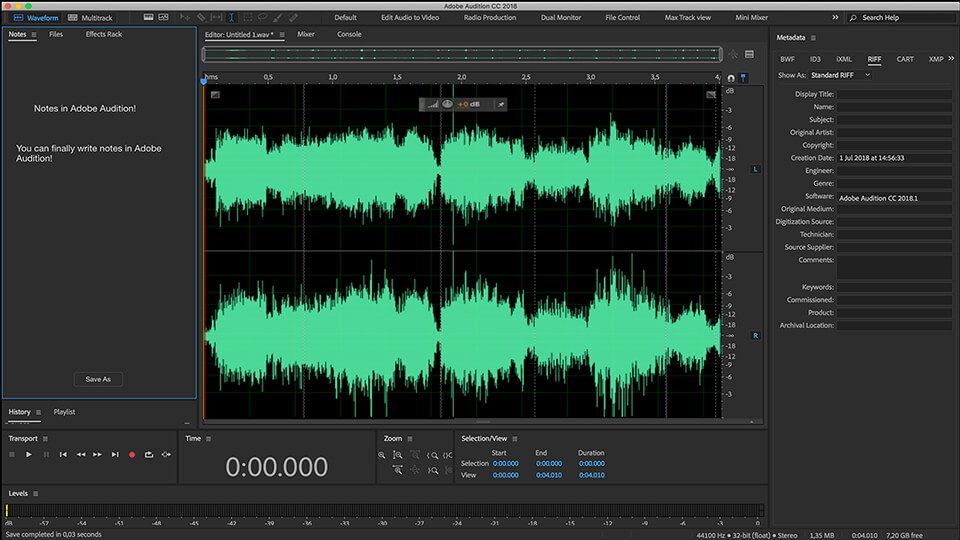- Adobe Audition 1.5 free. download full Version
- Adobe Audition For Audio
- Adobe Audio Effects
- Audio For Adobe Animate
- Adobe Audition Free Download
- Once you are done with the voiceover, press the spacebar to end the recording. A new audio file will appear on the track that was armed for recording. This file is saved in an automatically generated folder titled ‘Adobe Premiere Pro Captured Audio’, which is usually in the same directory as the project file, unless otherwise specified.
- Adobe® Audition® software includes thousands of uncompressed, royalty-free audio sound effects and music loop files. These files have been grouped together by type and style into ZIP archives that can be downloaded using the links below. Sound Effects - 27 bundles, over 10,000 high-quality sound effects.
- I wonder if Adobe has any plan to EVER make AE capable of playing back audio in real time. I use alot of apps, many of which are not 'purposed' for playing audio yet somehow they all manage to be able playback an audio file without hacks. All except for After Effects.
Edit, mix, record, and restore audio. Audition is a comprehensive toolset that includes multitrack, waveform, and spectral display for creating, mixing, editing, and restoring audio content. This powerful audio workstation is designed to accelerate video production workflows and audio finishing — and deliver a polished mix with pristine sound.
Adobe Audition 1.5 free. download full Version

Adobe Audition For Audio

Adobe has demonstrated tech that lets you edit recorded speech so that you can alter what that person said or create an entirely new sentence from their voice. It seems inevitable that it will eventually be referred to as 'photoshop but for audio.'


The tech, dubbed VoCo (voice conversion), presents the user with a text box. Initially the text box shows the spoken content of the audio clip. You can then move the words around, delete fragments, or type in entirely new words. When you type in a new word, there's a small pause while the word is constructed—then you can press play and listen to the new clip.
Adobe Audio Effects
VoCo works by ingesting a large amount of voice data (about 20 minutes right now, but that'll be improved), breaking it down into phonemes (each of the distinct sounds that make up a spoken language), and then attempting to create a voice model of the speaker—presumably stuff like cadence, stresses, quirks, etc., but Adobe hasn't provided much detail yet.
AdvertisementThen, when you edit someone's speech, VoCo either finds that word somewhere within the 20-minute clip—or if the word hasn't been uttered, it is constructed out of raw phonemes. At around the 4:30 mark in the video you can hear the phase 'three times' being constructed from scratch; if you listen carefully, it does sound a bit synthetic, but it's not awful. Copying and pasting existing words sounds better.
VoCo reminds me of an image editing tech that Adobe first demonstrated many moons ago: content-aware fill, which also creates something out of nothing. At the time, I remember people being concerned about the nefarious possibilities of almost flawlessly adding or removing details from images. With VoCo, it seems Adobe is being a bit more conscientious: even though it's just prototype tech, the company is already talking about 'watermarking and detection' to prevent fraudulent use.
Audio For Adobe Animate
Adobe Audition Free Download
VoCo was demonstrated at Adobe Max 2016, where the company usually shows off new tech a year or two before it's commercialised. If VoCo does make it out of the prototype stage, it would probably be added to Adobe Audition, where you could use it to edit podcasts and voiceovers, and, more importantly, to create really funny celebrity audio clips that you can share on Reddit. And to circumvent voice recognition tech currently being rolled out by banks. And to bombard your archenemy with heinous voicemails from their loved ones that sound legitimate, but were actually just made on your PC at home...
